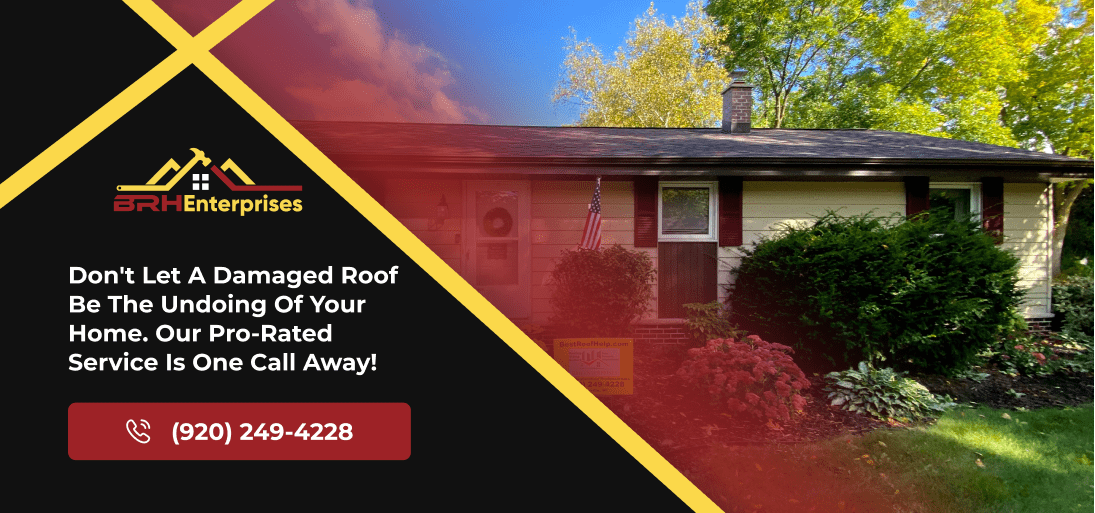Dark vs. Light Roof Shingles: Making the Right Choice for Your Home
Estimated Reading Time : 6 Min.

Choosing between dark and light roof shingles might seem like a purely aesthetic decision, but for Wisconsin homeowners, this choice impacts both the appearance and performance of your roof. The color of your shingles affects energy efficiency, temperature regulation, and how your roof handles Wisconsin’s seasonal weather throughout the year.
Southern Wisconsin experiences both extreme summer heat and frigid winter temperatures, making your shingle color choice important. Dark shingles absorb more heat, which can increase attic temperatures by up to 20 to 40 degrees compared to lighter colored options. This temperature difference directly affects your home’s energy consumption and comfort level throughout the year.
Beyond an influence on temperature, color choice also influences how your roof handles snow accumulation, resists algae growth in humid conditions, and complements your home’s overall appearance. Wisconsin homeowners must balance these practical considerations with neighborhood appearances and architectural style.
The right roof shingle color provides the optimal balance between visual appeal and functional performance. Understanding the specific advantages and disadvantages of dark versus light shingles in Wisconsin’s unique climate will help you make an informed decision that enhances your home’s protection, efficiency, and curb appeal for years to come.
Energy Efficiency: How Shingle Color Impacts Your Utility Bills
The color of your roofing shingles does more than define your home’s appearance; it directly affects your energy consumption and utility costs throughout Wisconsin’s diverse seasons. The color you choose creates a noticeable difference in how your home manages temperature regulation year-round.
Light-colored shingles reflect significantly more solar radiation than darker alternatives. During Wisconsin summers, this reflective quality prevents heat absorption and reduces attic temperatures by up to 50 degrees compared to dark shingles. This temperature reduction means your cooling system works less, potentially saving 20% to 30% on summer cooling bills. Many Wisconsin homeowners appreciate this benefit during increasingly warm summer months, especially in urban areas where heat retention is higher.
On the other hand, dark shingles serve an important purpose during long Wisconsin winters. By absorbing more solar heat, dark-colored shingles help warm your home naturally. This heat absorption accelerates snow melt, reducing ice dam formation and structural stress from heavy snow accumulation. The warming effect can also aid your heating system, particularly beneficial during sunny winter days when temperatures remain below freezing.
Overall, the best choice in roof color depends on your specific priorities. Southern Wisconsin homeowners who spend more on cooling than heating often benefit from lighter shingles, while those in northern regions with longer winters might prefer darker options. Your home’s insulation quality, level of tree coverage, and roof orientation also influence which color will maximize your energy efficiency.
Temperature Regulation: Measuring the Impact on Your Attic and Home
Research shows that dark roof shingles can reach temperatures up to 50 to 90 degrees hotter than the temperature of the surrounding air on sunny days, while light-colored shingles typically stay within 10 to 25 degrees of the surrounding air temperature. This dramatic difference directly affects your Wisconsin home’s comfort and energy consumption throughout the year.
Dark shingles absorb approximately 70% to 90% of the sun’s radiant energy, transferring this heat to your attic space. In comparison, light-colored shingles reflect 55% to 65% of solar radiation. During summer months, this absorption difference can result in attic temperatures exceeding 150 degrees with dark roofing materials, while light-colored roofs might maintain attic temperatures below 120 degrees under identical conditions.
However, shingle color is just one part of a comprehensive temperature regulation system. Proper attic ventilation works in tandem with your shingle choice by allowing hot air to escape before it transfers heat to living spaces. Similarly, adequate insulation (recommended R49 to R60 for Wisconsin homes) creates a thermal barrier that minimizes temperature transfer regardless of shingle color.
For Wisconsin homeowners, this means considering the roofing system as a whole. A well-ventilated, properly insulated attic with ridge and soffit vents can significantly offset the temperature effects of darker shingles in summer while still allowing beneficial heat gain during winter months. This balanced approach to temperature regulation ensures year-round comfort without sacrificing aesthetic preferences.
Seasonal Factors In Wisconsin That Should Influence Your Choice
Wisconsin’s distinct seasonal weather creates unique challenges for roofing materials that many homeowners overlook when selecting shingle colors. Our state experiences temperature swings from below-freezing winters to humid 90-degree summers, making your shingle color choice particularly impactful for long-term roof performance.
During the winter, dark-colored shingles provide a significant advantage by absorbing more solar heat, which accelerates the rate of snow melt and reduces ice dam formation. This natural warming effect can prevent dangerous ice accumulation and minimize the freeze-thaw cycles that damage roofing materials over time. Many Wisconsin homeowners appreciate how dark shingles help shed snow loads that could otherwise add too much weight to the roofing structure and cause it to fail.
However, summer considerations tell a different story. Light-colored shingles reflect more solar radiation, keeping your attic significantly cooler during hot summer days. This reflective quality reduces thermal shock, which is the expansion and contraction that occurs when materials rapidly heat and cool, effectively extending the lifespan of the shingles in Wisconsin’s variable climate.
The freeze-thaw cycles unique to Wisconsin create additional considerations. Dark shingles experience more dramatic temperature changes between day and night, potentially accelerating weathering. Meanwhile, light shingles maintain more stable temperatures but may show algae growth more visibly in our humid summers. Understanding these seasonal interactions helps Wisconsin homeowners make climate-appropriate roofing choices that balance year-round performance.
Durability and Longevity: Color’s Role in Shingle Performance
When investing in a new roof for your Wisconsin home, understanding how color affects shingle durability can save you from premature replacement costs. The relationship between shingle color and how long the shingle will last in providing protection is more significant than many homeowners realize, especially in our region’s varied climate conditions.
Darker shingles typically absorb more heat, which accelerates the aging process through thermal stress. This continuous expansion and contraction cycle can cause granule loss and material deterioration over time. When these dark shingles reach extremely high temperatures, their lifespan is potentially reduced by 5 to 10 years compared to lighter alternatives in severe cases.
However, darker shingles offer practical advantages in Wisconsin’s climate. They mask algae streaks, moss growth, and environmental staining that commonly affect roofs in our humid summers. Light-colored shingles show these imperfections more readily, often appearing prematurely aged even when they’re structurally sound.
Wisconsin’s freeze-thaw cycles create additional considerations. While dark shingles help melt snow faster, they also experience more dramatic temperature fluctuations between day and night. Light-colored options maintain more consistent temperatures throughout seasonal changes, potentially reducing stress-related deterioration.
Aesthetic Considerations: Balancing Curb Appeal with Practical Benefits
While energy efficiency and climate performance are crucial factors when selecting roof shingle colors, the aesthetic impact on your Wisconsin home cannot be overlooked. Your roof typically represents 40% of your home’s visible exterior, making it a defining element of your property’s curb appeal and overall value.
When coordinating roof colors with your home’s exterior, consider the principle of contrast. Dark roofing often pairs beautifully with lighter siding colors, creating visual balance, while lighter shingles can enhance homes with darker exteriors. Wisconsin homeowners should also consider their architectural style, since traditional Colonial and craftsman homes often benefit from darker shingles that create a grounded appearance, while contemporary and ranch-style homes may appear more spacious with lighter roofing materials.
Current roofing trends in Southern Wisconsin show growing popularity of mid-tone shingles in weathered wood, slate gray, and sandy beige tones. These versatile options balance energy efficiency with practical benefits while maintaining broad aesthetic appeal. Many homeowners are selecting dimensional or architectural shingles that provide depth and visual interest regardless of color choice.
The look of local neighborhoods should also factor into your decision. While you want your home to stand out positively, roofing colors with extreme contrast can appear out of place. Many Wisconsin communities have found that medium-toned shingles with slight color variations provide the ideal balance between energy performance and visual harmony with surrounding properties.
Making Your Decision: A Wisconsin Homeowner’s Guide to Shingle Selection
After weighing the various factors of dark versus light shingles, it’s time to make your final decision based on your specific circumstances. For Southern Wisconsin homeowners, this means balancing energy efficiency, seasonal performance, and aesthetic considerations unique to your property. Start by evaluating your home’s orientation, as south-facing roofs receive more direct sunlight, making light-colored shingles potentially more beneficial for cooling costs, while north-facing roofs might benefit from dark shingles’ heat absorption.
Your property’s surroundings also matter significantly. Homes with substantial tree coverage experience less direct sun exposure, potentially reducing the temperature difference between light and dark shingles. Consider your home’s level of insulation too, as well-insulated homes with proper ventilation systems can better manage the heat transfer from darker shingles, giving you more color flexibility.
Discover the Best Roof Shingles for Your Wisconsin Home with BRH Enterprises LLC
Choosing the right roof shingle color is more than just a matter of appearance; it’s about making a smart decision that enhances both the energy efficiency and durability of your home. Whether you’re considering the heat absorption benefits of dark shingles or the reflective advantages of light shingles, it’s essential to factor in Wisconsin’s unique climate. At BRH Enterprises LLC, we understand these nuances and are here to guide you through each step of the selection process.
Don’t let the complexity of choices overwhelm you. Call us today at (920) 249-4228 and let our experts help you decide which roof shingles are better for your home, balancing curb appeal with practical benefits.


